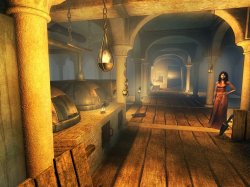|
Cleopatra Riddle of the Tomb
 Set in Alexandria in ancient Egypt at the time of the rivalry between Queen Cleopatra and her brother, Ptolemy, this game tells the tale of the mapping of Cleopatra's destiny. You play as Thomas, a young astrology student, in love with Iris, daughter of Akkad your mentor, who also happens to be Cleopatra's chief astrologer. As the game opens there are signs of a desperate struggle in the magnificent gardens and Akkad and Iris have disappeared. Following the clues they left behind it's your task to find them and ultimately deliver Cleopatra's astrological readings into her hands.
Cleopatra Riddle of the Tomb (also published under the title Cleopatra A Queen's Destiny) is a first person perspective adventure game with some quite beautiful graphics, if not absolutely state of the art. Movement is from node to node and you can spin around 360 degrees, look up and down, and intricately search and admire your surroundings. It's not a huge gameworld, or a particularly long game, but the outside settings are quite picturesque, befitting of a high-class abode, and the various inside locations including Akkad's laboratory, a tomb of course, and a great cavernous underground hall are very impressive.
There are just 4 or 5 main locations marked on a map for you to jump to and fro once they are accessible. Each location has a number of screens and, despite the map; there isn't too much backtracking as the game leads you ever onwards. The puzzles are not overly difficult for experienced players but there's plenty for novices and casual players to sink their teeth into. Maybe the potion mixing is laid on a bit thick but there's a fair variety of things to do and lots of messages and notes that must be carefully scrutinized to overcome problems. Some puzzles are quite lengthy and involved and satisfying to complete. There are quite a few items to find but they aren't too elusive as the various areas are compact and what you need is invariably close at hand. There are contraptions to get working too, and as well as in the documents you collect, the drawings on walls and on the sides of tombs hold useful clues. Set in Alexandria in ancient Egypt at the time of the rivalry between Queen Cleopatra and her brother, Ptolemy, this game tells the tale of the mapping of Cleopatra's destiny. You play as Thomas, a young astrology student, in love with Iris, daughter of Akkad your mentor, who also happens to be Cleopatra's chief astrologer. As the game opens there are signs of a desperate struggle in the magnificent gardens and Akkad and Iris have disappeared. Following the clues they left behind it's your task to find them and ultimately deliver Cleopatra's astrological readings into her hands.
Cleopatra Riddle of the Tomb (also published under the title Cleopatra A Queen's Destiny) is a first person perspective adventure game with some quite beautiful graphics, if not absolutely state of the art. Movement is from node to node and you can spin around 360 degrees, look up and down, and intricately search and admire your surroundings. It's not a huge gameworld, or a particularly long game, but the outside settings are quite picturesque, befitting of a high-class abode, and the various inside locations including Akkad's laboratory, a tomb of course, and a great cavernous underground hall are very impressive.
There are just 4 or 5 main locations marked on a map for you to jump to and fro once they are accessible. Each location has a number of screens and, despite the map; there isn't too much backtracking as the game leads you ever onwards. The puzzles are not overly difficult for experienced players but there's plenty for novices and casual players to sink their teeth into. Maybe the potion mixing is laid on a bit thick but there's a fair variety of things to do and lots of messages and notes that must be carefully scrutinized to overcome problems. Some puzzles are quite lengthy and involved and satisfying to complete. There are quite a few items to find but they aren't too elusive as the various areas are compact and what you need is invariably close at hand. There are contraptions to get working too, and as well as in the documents you collect, the drawings on walls and on the sides of tombs hold useful clues.
 There are several characters to meet as you go though ancient Alexandria isn't teeming with life by any means. Friend or foe each character has some help to offer, so take care to exhaust every conversation. If at any time you don't see a way forward then chatting to a character is usually the answer as they will likely trip the trigger to move to the next event. Having said that there isn't a lot of dialogue and it's simply a matter of selecting the character and then a dialogue option from a small list that appears. The voice acting is a little patchy but fairly good overall, what rings a few alarm bells is the actual choice of words. Sometimes they are a bit too glib, too modern, and this will jump out at you from time to time.
Cleopatra Riddle of the Tomb is simple point and click with the occasional sliding or dragging action involved. A smart cursor tells you when there is something to do. If you've played other games from Kheops Studio such as Return to Mysterious Island or Voyage: Inspired by Jules Verne then you'll be quite at home with the interface here. A click of the left mouse button brings up an in-game options screen where the inventory is huge. It has 6 pockets each containing 24 slots so there's plenty of opportunity to organize your goodies. As you collect items they accumulate in a holding box from where you can sort them appropriately into various pockets. Each inventory item is clearly labeled so you can't go wrong here.
Once again there is an 'Assembly Zone' beneath the inventory with help for combining objects. They can also be taken apart if necessary although I don't recall using this function. This options screen also contains the 'saving' icon and as far as I could tell there are limitless save games slots. Other icons include a notebook that keeps track of the game so if you're forgetful, or take a break for any period of time, it is there to remind you what's happened. Another notebook records all conversations and then there's the Documents folder which collates all the notes you have found, as well as an icon for the map mentioned above. There are several characters to meet as you go though ancient Alexandria isn't teeming with life by any means. Friend or foe each character has some help to offer, so take care to exhaust every conversation. If at any time you don't see a way forward then chatting to a character is usually the answer as they will likely trip the trigger to move to the next event. Having said that there isn't a lot of dialogue and it's simply a matter of selecting the character and then a dialogue option from a small list that appears. The voice acting is a little patchy but fairly good overall, what rings a few alarm bells is the actual choice of words. Sometimes they are a bit too glib, too modern, and this will jump out at you from time to time.
Cleopatra Riddle of the Tomb is simple point and click with the occasional sliding or dragging action involved. A smart cursor tells you when there is something to do. If you've played other games from Kheops Studio such as Return to Mysterious Island or Voyage: Inspired by Jules Verne then you'll be quite at home with the interface here. A click of the left mouse button brings up an in-game options screen where the inventory is huge. It has 6 pockets each containing 24 slots so there's plenty of opportunity to organize your goodies. As you collect items they accumulate in a holding box from where you can sort them appropriately into various pockets. Each inventory item is clearly labeled so you can't go wrong here.
Once again there is an 'Assembly Zone' beneath the inventory with help for combining objects. They can also be taken apart if necessary although I don't recall using this function. This options screen also contains the 'saving' icon and as far as I could tell there are limitless save games slots. Other icons include a notebook that keeps track of the game so if you're forgetful, or take a break for any period of time, it is there to remind you what's happened. Another notebook records all conversations and then there's the Documents folder which collates all the notes you have found, as well as an icon for the map mentioned above.
 The opening screen for Cleopatra Riddle of the Tomb depicts a sumptuous room in Cleopatra's apartments; it's here where you come to save your game. The various room exits allow you to continue the present game, exit the game, or start a new one. In one area various furnishings will prompt you to enable subtitles, adjust the overall sound and the panning speed. It all looks very pretty although I must confess I'm in favour of a more functional screen that clearly labels different options.
When starting out a new game you are prompted to choose an avatar from five Egyptian gods sitting on a small table. This keeps 5 games separate and allows 5 players to play along. Next up you're prompted to choose a sign of the zodiac and a note alerts you that this choice will have an influence on the game. However the 'influence' isn't drastic, it simply means that there may be an extra step or two to take in solving some of the puzzles. The item you need might be broken, for instance, and you'll have to fix it before use, or you may have to improvise for a missing object. When you get through to the end you are then offered the opportunity to replay the game in 'Cursed by the Gods' mode complete with all the little hitches, or in 'Blessed by the Gods' mode where everything goes right.
Cleopatra Riddle of the Tomb shouldn't take too long to complete and it's up to you whether or not you want to play again to catch all the hitches - or not! It's a diverting little game but it doesn't reach any great heights. The story is very simple and serious though there is some fun to be had in meeting up with Iris and helping her out. I must confess I did crack a smile on at least one occasion when Thomas expressed his relief that the fire in the Library of Alexandria hadn't spread too far and didn't do too much damage! The opening screen for Cleopatra Riddle of the Tomb depicts a sumptuous room in Cleopatra's apartments; it's here where you come to save your game. The various room exits allow you to continue the present game, exit the game, or start a new one. In one area various furnishings will prompt you to enable subtitles, adjust the overall sound and the panning speed. It all looks very pretty although I must confess I'm in favour of a more functional screen that clearly labels different options.
When starting out a new game you are prompted to choose an avatar from five Egyptian gods sitting on a small table. This keeps 5 games separate and allows 5 players to play along. Next up you're prompted to choose a sign of the zodiac and a note alerts you that this choice will have an influence on the game. However the 'influence' isn't drastic, it simply means that there may be an extra step or two to take in solving some of the puzzles. The item you need might be broken, for instance, and you'll have to fix it before use, or you may have to improvise for a missing object. When you get through to the end you are then offered the opportunity to replay the game in 'Cursed by the Gods' mode complete with all the little hitches, or in 'Blessed by the Gods' mode where everything goes right.
Cleopatra Riddle of the Tomb shouldn't take too long to complete and it's up to you whether or not you want to play again to catch all the hitches - or not! It's a diverting little game but it doesn't reach any great heights. The story is very simple and serious though there is some fun to be had in meeting up with Iris and helping her out. I must confess I did crack a smile on at least one occasion when Thomas expressed his relief that the fire in the Library of Alexandria hadn't spread too far and didn't do too much damage!
Copyright © Rosemary Young, 2008.
All rights reserved.
System Requirements:
Win XP/Vista, 800 MHz Pentium 3 (1 GHz Pentium 4 or higher recommended), 128 MB RAM (256 MB recommended), 1.8 GB free Disk Space, 4 x DVD-ROM (8x recommended), DirectX Compatible Sound Card, 64 MB DirectX 9.0c Compatible Video Card (128 MB recommended) Mouse, Keyboard and Speakers.
|

